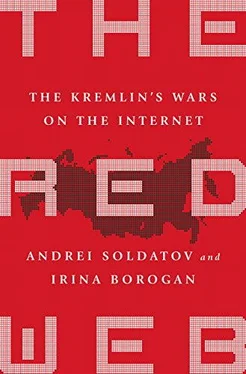When Stalin’s security services in the 1930s and 1940s needed to conduct secret research in particular areas, they arrested scientists and engineers and sent them to special installations, the sharashkas, which were closed off from the outside and heavily guarded. The scientists and engineers were motivated to produce quick results under the threat of being sent to labor camps if they failed. But in the years after Stalin’s death in 1953 this system evolved into a far-reaching system of research institutes, not all of them closed. A result was that many thousands of Soviet engineers were working in security or military research.
The sharashka in Marfino, east of Moscow, was especially important, and by 1948–1949 it had become a relatively large research effort, with 490 personnel, of which 280 were prisoners, divided into twelve research groups, including the acoustic laboratory of Major Abram Trakhtman. [1] Konstantin Kalachev, V kruge tretiem [In the Third Circle]. Kalachev worked as a researcher at Marfino from 1947 to 1996, and in 1999 he wrote a history of the Marfino project. The book never made it into print and is available only on the site: http://anmal.narod.ru/kniga/kniga.html .
Marfino’s main task was to develop a special kind of secure telephone system that would allow Stalin to speak on the phone without interception. To accomplish that, the voice on the phone would have to be split into pieces, coded, and then reassembled. The problem was not only how to code the pieces but also how to repair the speech in a way so that the speech and speaker would be instantly recognizable. For months Marfino’s acoustic laboratory tried to make the decoded speech recognizable. The effort required the focus of both inmates and their superiors. They worked under the guidance of Trakhtman, but the real brain behind the research effort was Lev Kopelev, an inmate. He was considered the top expert on recognizing speech, with an unerring ear for accents and a deep grasp of the physics of sound waves.
In the late autumn of 1949, at the yard of Marfino, Kopelev approached his closest friend, Alexander Solzhenitsyn, a fellow inmate, to share with him a state secret. Kopelev had successfully listened to and identified a caller who gave sensitive information to the US Embassy about the atomic bomb. [2] Lev Kopelev, Utili moi pechaly [Soothe My Sorrows] (Moscow: Novaya Gazeta, 2011).
Kopelev was incensed.
Although he had been convicted and sentenced for expressing his disapproval of the Soviet troops’ harsh treatment of the German population in 1945, Kopelev remained a devoted Communist and Soviet patriot, and he was outraged to listen to someone who had just betrayed such a big secret to the Americans. He was given four audio tapes—it turned out the speaker tried three times to reach the US Embassy and then gave up and called the Canadian Embassy once. The security services intercepted and recorded all the conversations. Kopelev was also given samples of phone conversations of three suspects. With his considerable skills and talents, Kopelev pointed the finger at one of the recorded voices, leading the authorities to a certain foreign ministry official, who was arrested. It was a major—and unexpected—victory for the sharashka. Excited, Kopelev couldn’t help but tell his friend Solzhenitsyn what he had done. Kopelev coined the term phonoscopy for the new scientific discipline of recognizing the identity of a speaker on the phone, one that would be very valuable to the security services for many years to come. [3] In the uncensored edition of The First Circle , Solzhenitsyn carefully changed all the names except for the betrayed Soviet spy Koval; apparently he thought it was not a real name. As it turned out, he was wrong.
In July 1950 the secure telephone technology for Stalin was finished, as was the main assignment for Marfino. For the next two years Marfino created a manufacturing line for the equipment they had invented. When that was completed, the sharashka was essentially divided in half. The specialists on secure telephony were left there, and it was renamed to become the top-secret National Research Institute No. 2, working on the protection of Kremlin telecommunications, as it does to this day. The other half of specialists, who had worked in the acoustic laboratory, including Kopelev, were moved to Kuchino, another sharashka located outside of Moscow.
This was a fateful move that established the KGB’s central role in research and development of listening devices and eavesdropping for the next half century. The transfer to Kuchino meant that the secret services would do the research on speech recognition technology in the same facility—and guided by the same people—as those working on wiretapping. They wanted to make sure they could not only intercept a conversation but also have the means to identify those who spoke on the phone. The KGB wanted full control of telecommunications, and from this time on, identifying a speaker was considered a legitimate part of Soviet surveillance.
Kuchino, surrounded by high walls seventeen miles east of Moscow, was the main research facility for Stalin’s secret services in the area of special, or “operative,” equipment—ranging from weapons to radio sets to, most importantly, listening devices. In one of their most ambitious and successful exploits, the experts at Kuchino planted a listening device inside a large replica of the Great Seal of the United States and presented it as a gift to the US ambassador in August 1945, and it was hung in the ambassador’s study. The device transmitted sound waves out of the ambassador’s study to the Soviet secret services until it was exposed in 1952.
Kopelev left Kuchino in 1954, a year after Stalin died, never to return to his research in phonoscopy. He went on to become a dissident. But he left his archives behind in Kuchino, and they were carefully preserved. For a time the security services didn’t know what to do with them; it seemed that the technology Kopelev invented was based on his knowledge alone and wouldn’t work without him. In other words, without Kopelev’s unique skills, it was useless to try to identify a speaker on the phone. [4] In June 1997 Kopelev died in Cologne. A few months before, in January 1997, in Moscow, Solzhenitsyn went back to Marfino—as a visitor. The visit needed weeks of negotiations, as it remains a highly secret facility, manned by what was then called FAPSI, the Russian electronic intelligence agency. On January 16, 1997, the gates opened to let in Solzhenitsyn’s cherry-red Volvo. Solzhenitsyn was full of memories. “I never thought I could visit this place again. I walked and couldn’t stop, in some rooms—incredibly!—everything is as it was then.” Eventually he was shown into the large room where over five hundred employees gathered. In 1997 Marfino suffered three months’ delay in payment of salaries, and the employees asked Solzhenitsyn anxiously, “What should we do? Does our country need us?” They called him a colleague. The only media report from the meeting said, “They felt in today’s Solzhenitsyn an accomplice and applauded.” Vladimir Umnov, “Solzhenitsyn snova v sharashke” [Solzhenitsyn Is Again in Sharashka], Ogonyok , January 27, 1997, www.ogoniok.com/archive/1997/4487/04–20–21 .
But other research began to show that there was a method behind Kopelev’s success. The first evidence came in 1960 when a Swedish scientist, Gunnar Fant, published a monograph, The Acoustic Theory of Speech Production , based on his research at MIT. [5] Gunnar Fant, Acoustic Theory of Speech Production (The Hague, Netherlands: Mouton and Co, N.V. Publishers), 1960.
He had found a way to slice up a voice recording into samples and then identify them using mathematics and physics. This meant that there was a more reliable and verifiable scientific method instead of relying on Kopelev’s skills. Fant’s discovery, translated into Russian in 1964, led to a surge of secret research into the topic inside the Soviet Union. [6] Gunnar Fant, Akusticheskaya teoria recheobrazovania [Acoustic Theory of Speech Production] (Moscow: Nauka, 1964).
Читать дальше












